Meetings Past
November 18, 2006 Meeting Highlights
by Mary Jane Dapkus
Attendance at Chapter 148's November 18, 2006 meeting exceeded previous record levels. The chapter's phenomenal growth in recent years stems from the efforts of its dedicated volunteers, whom chapter president Jim Katzin recognized during this last meeting of 2006.
Indeed, Chapter 148 celebrates its volunteers' commitment in transforming ideas into vibrant meetings and marts. Since the chapter's strength relies on an informal organization, all are invited to express their thoughts for future meetings and events, and to contribute assistance, be it in large or small ways.
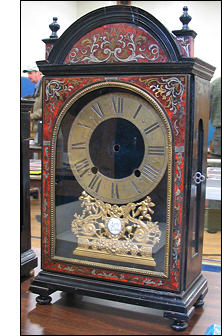 The mart featured another in a series of thought-provoking impromptu exhibits provided by member David Follett. David's collecting interests encompass a broad spectrum of the field; his exhibits draw on resources of a fine library and collection. As the happy result, David's table connects and uplifts passers-by. The mart featured another in a series of thought-provoking impromptu exhibits provided by member David Follett. David's collecting interests encompass a broad spectrum of the field; his exhibits draw on resources of a fine library and collection. As the happy result, David's table connects and uplifts passers-by.
In November, David introduced members to three very fine and rare examples of the earliest pendulum clocks. The first consisted of a Dutch example attributed to Salomon Coster (d. 1657). The clock exhibited several patented features described in Christian Hugens 17th century treatise "De Res Pendularum".
The second elaborately cased example contained a Dutch movement also by Coster, featuring the characteristic patented round pendulum ball and cycloidal cheeks. The third, a religiously inspired example, featured an exquisite marquetry case crafted by Henri Boulle (see photo), and a rack-and-snail strike, month-running movement produced by one of the Ourry family of French clock makers (not shown in photo).
David graciously responded to questions, reaching for his copy of Tardy's beautifully written, sumptuously illustrated 3rd edition of "La Pendule Francaise" from which he read with impeccable accent and pronunciation. Members helped translate.
Margaret Rodgers of South Dartmouth, MA provided a thoughtfully organized workshop in early American bronze stenciling techniques. Aside from workshops, Margaret, an expert dial restorer, clock decorator, and long-time NAWCC member, provides private classes and also serves as an instructor at the renowned Historical Society of Early American Decoration (HSEAD). For those not yet familiar with this organization, HSEAD offers many resources for in-depth study and training in several areas of interest to artists and restorers.
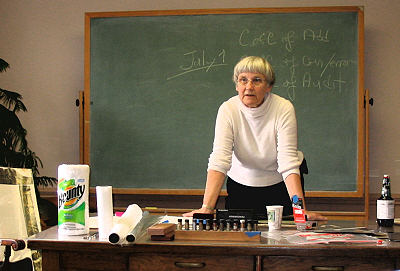
Margaret initiated those in attendance to stenciling materials and techniques including the use of slow-drying varnish, architect's linen, and the best ways to cut stencils. She then assisted members develop skills in applying bronze powders--and correcting errors before the varnish sets. Hearty thanks is due to Margaret and her capable assistant, Nancy Corcoran of Plymouth, MA, for skillfully guiding many first-time stencilers to a level of confidence they did not consider possible at the outset.
September 16, 2006 Meeting Highlights
by Mary Jane Dapkus
The chapter's September meeting provided many opportunities to share both the intellectual and sensual pleasures of collecting. As an excellent example of the latter, kudos belong to tableholder Joe Kaddis for an impeccable eye--and ear: an early 20th century French mechanical songbird in a gilded cage perched on Joe's table, enchanting passers-by with its winsome song.
Indeed, our members' interests span the globe. Several recently attended the antique clock and watch fair at Furtwangen, Germany, a traditional end-of-summer event. One member's Swiss Pendulette watch, with a tiny Neufchatel clock dial integrated in the bottom of the watch's face, prompted others to recall trips to Neufchatel to visit the famous automota museum there. Members also reminisced about trips to Switzerland to attend the annual jewlers' and watchmakers' trade show in Basal--an event that attracts as many as 80,000 visitors from all over the world.
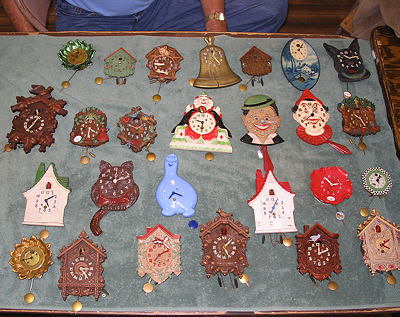
A collection of Lux Keebler miniature wall clocks spotted at the table of Ed Kazemekas.
(click photo lor larger view)
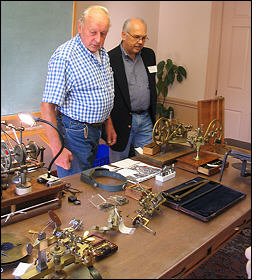 The September meeting featured a presentation by Mel Smith (left in picture) of Katonah, NY on chronological developments in antique gear cutting machinery. To illustrate, Mel, a master machinist, noted horologist, NAWCC contest winner, and long-time watchmaker, brought along several very rare pieces from his own collection. (click picture for larger view) The September meeting featured a presentation by Mel Smith (left in picture) of Katonah, NY on chronological developments in antique gear cutting machinery. To illustrate, Mel, a master machinist, noted horologist, NAWCC contest winner, and long-time watchmaker, brought along several very rare pieces from his own collection. (click picture for larger view)
Following the laborious process of marking out gears with a protractor, saw-cutting and hand-filing utilized as early as the 12th century, a quicker way to index gear teeth by means of a mounted, rotating disk emerged. Although much hand-work remained, the early 18th century watch or clockmaker could now complete as many as 20 gears per day.
Before the first decade of the 19th century passed, Connecticut native Eli Terry was cutting both leading and trailing edges of wooden gear teeth in a single pass utilizing two saw blades mounted in tandem. The developments of fly cutters (surviving examples of which are especially scarce), and constant profile cutters to cut steel pinions followed. By the mid-19th century, sliding, dovetailed cutters emerged. The late 19th century marked the development of lathes.
After his talk, Mel generously invited members to handle and actually use the assembled cutting engines. Many remarked on the machines' oddly austere beauty. The tools required much skill to use, but most who attempted concluded improvement would surely follow with practise.
The chapter extends its hearty thanks to Mel for graciously providing the opportunity to see and test these unusual artifacts. P.S.--If you would like to hear more from Mel, he plans to team with Harry Blair to present the history of the Bulova Accutron tuning fork watch at an upcoming Chapter 2 meeting in Long Island this October.
July 15, 2006 Meeting Highlights
by Mary Jane Dapkus
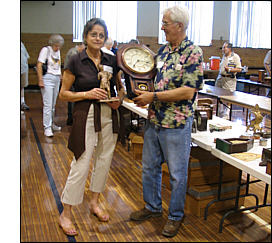 The chapter met on July 15, a sultry Saturday morning marking the end of Brimfield week. Entering the Edmond Town Hall's quaint, cool basement, members found much to spark their interest and conversation. The chapter met on July 15, a sultry Saturday morning marking the end of Brimfield week. Entering the Edmond Town Hall's quaint, cool basement, members found much to spark their interest and conversation.
Pictured here discussing recent findings are Lu Sadowski, president of chapter 2, and previous organizer of the Timexpo, with Peter Belliveau.
Items spotted on mart tables included a triple-box Waltham deck watch ca. 1920. Collector/restorer David Follett, who purchased this treasure, cheerfully exhibited it at his table. The watch was in original, running condition, with a superb walnut case and brass trimmings. The case was missing one of its lids used to keep out sea spray as a ship's watchman made his rounds. We left David happily planning the lid's accurate restoration with friends.
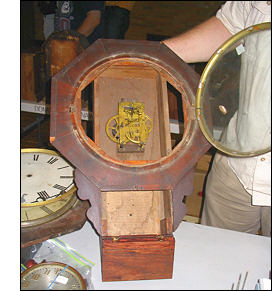 Another object that attracted well-deserved attention was an early-to-mid-19th century wall timepiece with the label of John Peacock, probably American, hitherto unknown (see photo). Research efforts are underway. Another object that attracted well-deserved attention was an early-to-mid-19th century wall timepiece with the label of John Peacock, probably American, hitherto unknown (see photo). Research efforts are underway.
Running the announcement and raffle aspects of the meeting fell to Don Bruno, and he accomplished these tasks with characteristic grace.
Between drawings, it was my great pleasure to converse with the wise and witty Audrey Drucker of Long Island, partner in WatchBandWorld.com.
Our guest speaker was Girard (Gerry) Kevorkian, of Delray Beach, FL. At an auction nearly forty years ago, Gerry's dream of owning a true American original, a J.C. Brown acorn shelf clock of 1847-1848 (worth as much as $30,000), seemed to slip away. Upon reflection, Gerry decided to develop an affordable reproduction of this clock (see below photo).
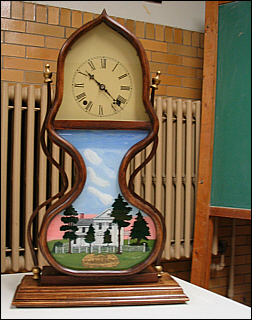 Gerry's achievement is no small accomplishment. Elaborate steaming, bending, and press-forming processes, not to mention scarce materials required for this classic rendered it very costly to produce in its own time. Gerry began by studying existing examples in museums, and by experimentation, -- the latter at first resulting in failure. Gerry's achievement is no small accomplishment. Elaborate steaming, bending, and press-forming processes, not to mention scarce materials required for this classic rendered it very costly to produce in its own time. Gerry began by studying existing examples in museums, and by experimentation, -- the latter at first resulting in failure.
Gerry shared some of the unique challenges and his own techniques for reproducing the acorn clock, including cutting kerfs in basswood for the clocks' sides, and soaking the pieces to render them bendable. Although some of the materials Gerry utilizes are inexpensive; others, for example, the solid mahogany base, are not. The clock's door must be cut from a single costly mahogany board to provide the required durability.
The clocks also require enormous amounts of finish work in the form of sanding, filing, shaping, and trimming. Tablets depicting J.C. Brown's residence are hand painted offsite. Currently, the clocks come fitted with Hermle 8-day movements.
Gerry has produced an amazing total of fifty-seven original reproduction acorn clocks. Orders require a lead time of eight weeks to fill. Gerry's diligence and achievements provided inspiration to all in attendance: we thank him for sharing his experiences so generously.
* * *
Back to top of page
May 20, 2006, Meeting Highlights
by Mary Jane Dapkus
Chapter 148's May, 2006, meeting convened on Saturday the 20th. Those who arrived found spirited company, lively trading, and plentiful opportunities to learn.
|
Chapter members Walter Weber and his wife Ethel have been scouring mart tables together longer than most of us can remember, and their pleasure in doing so is quite contagious. Walter and Elthel's collecting interests ranges from the technical to the whimsical. Explaining that a previous chapter highlight sparked the memory of a past discovery, Walter brought along one of his most exciting finds ever to share with friends.
Much to members' awe, the couple presented an 18-size New York Standard Watch Company watch -- with a straight-line lever and extremely rare worm gear escapement, in mint, running condition! Walter explained that R.J. Clay of Jersey City, the company's home, received a patent for this model on October 16, 1886. Clay and William Hanson of Brooklyn, NY, modified the patent during the following year, and their firm produced the watch only during 1888. This remarkable object's escape wheel is situated perpendicular, rather than parallel, to its balance wheel. Although 12,000 were made, Walter explained that few survived. As he and Ethel helped me photograph it, Walter politely declined several offers to purchase the watch.
Sorry, but Walter Weber's watch was difficult to photograph freehand. The worm gear is located inside the star-shaped opening.
|
|
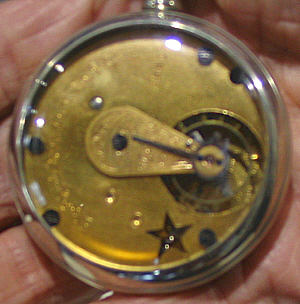 |
Expert clock dial restorer, Frank Machera of Pleasantville, NY, provided a workshop for chapter members in his genteel art. An early student of New York City's School of Industrial Arts, now the New York City School of Art and Design, Frank has professionally returned many dials damaged by accident, catastrophe, and less than desirable storage conditions to their former glorious beauty.
Frank explained his methods for tracing evidence provided on damaged dials with pencil, and transferring the tracings back on to the dial using carbon paper or graphite. Arabic numerals may be outlined with India ink using Rapidograph technical pens and a T-square, then brushed with rapid strokes. Several coats of gold powder dissolved in varnish or Liquitex (a latex with gold) provide an alternative to gesso for building up small raised gold areas within the dials. The latex product is opaque, and spills clean up easily using soap and water.
Frank generously shared information on equipment and supplies for dealing with various types of problems encountered in dial restoration. Examples included versatile Paasche air brushes, templates, Krylon primer for wood or metal, and all-purpose sheetrocking joint compound for filling cracks and chips. Based on the examples provided, Frank''s materials and methods, combined with his professional training, skill, and research relative to trademarks and examples, not to mention fifteen years of experience intensely focusing on dial restoration, yield truly fabulous results.
A Canadian correspondent has contacted our chapter seeking an example of a Samuel Canfield, Middletown, CT, tall clock case in connection with a restoration project. Anyone with information is encouraged to contact the chapter.
The Connecticut Commission on Culture and Tourism will feature the American Clock and Watch Museum in Bristol, CT, as a venue for its "Connecticut Open House" tour on June 10. Admissions to the museum and other historic properties on that date will be reduced or free, and will feature music, refreshments, and children's activities. All are cordially invited.
* * *
Back to top of page
March 18, 2006 Meeting Highlights
by Mary Jane Dapkus
Chapter 148 met on a cold and windy Saturday morning, March 18. Tables at the mart continue to sell out to a most cordial and hard-working group of sellers. As those who have the pleasure of attending regularly know, hard-to-find items turn up in every imaginable collecting area. The March mart was no exception. Indeed, our chapter's strength lies in the vast expertise that comes together on these all-too-brief occasions.
As I wandered from table to table, an outstanding collection of 19th century pocket watches caught my eye at the table of John Hotz of Valley Stream, NY. I stopped to admire an American Watch Company (P.S. Bartlett) 18-size key-wind, key-set watch with a solid balance wheel, relatively low serial number, and hunting style case. Besides several "stage coach" watches, I was also attracted to a 15-jewel Illinois Watch Company 18-size lever-set "transition" watch, having both crown-wind and key-wind features. Not the least of my pleasures in tarrying at his table were the lessons John provided in pre-World War I Eastern European history in between descriptions of each terrific watch.
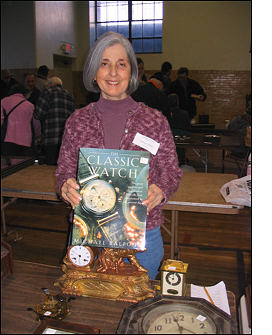 The March mart was also a fantastic day for reference books, both new and rare. Among many treasures spotted were a reprint of an early work on milling and milling machines originally published in 1919, and Michael Balfour's The Classic Watch, 2002 (see photo of Kathy Kaddis holding the book). The March mart was also a fantastic day for reference books, both new and rare. Among many treasures spotted were a reprint of an early work on milling and milling machines originally published in 1919, and Michael Balfour's The Classic Watch, 2002 (see photo of Kathy Kaddis holding the book).
The March meeting celebrated the American Clock and Watch Museum (ACWM) of Bristol, CT with a presentation given jointly by Chris Bailey, the museum's horologist since 1972, well-respected for both his knowledge and candor, and Don Muller, the museum's amiable and dedicated executive director, on the history of the museum's collections and of its inner workings. We learned that Edward Ingraham of Bristol established the non-profit museum in 1952 as he sensed the decline of Connecticut's clock industry and the need to preserve his own collection then housed on the third floor of his home on Grove Street. Ingraham feared the collection's dispersal would result in the loss of part of America's industrial history with important local ties. As luck would have it, Ingraham enlisted the support of a local collector and Terry family decedent, banker Charles Treadway.
Chris and Don opened a dialog on ways to deepen connections between the museum and chapter members. A trend toward increasing competition has hurt the tourist trade including museums nationwide. The museum is essentially a library of objects and artifacts, and members are encouraged to call, email, or write freely to let Don and Chris know if they have specific suggestions for programs or exhibits to meet their needs and interests.
The ACWM recently mounted a new exhibit that features a complete set of Seth Thomas jewelled watches, visible from both front and behind. The core of this great collection was provided by Dan Gaenger of Florida.
The museum has also received inquiries from a local television station that wants to do a program featuring the museum's capable clock winders, chapter members Mel Brown and Paul D'April. Stay tuned for an update.
January 21, 2006 Meeting Highlights
by Mary Jane Dapkus
Chapter 148 met on January 21, a spring-like Saturday morning. Although the chapter traditionally does not feature special technical presentations in January, both attendance and pre-registration for the coming year were well above last year's levels. This vibrant chapter continues to grow--a phenomenon that can only be attributed to the outstanding qualities of its members.
Among abundantly stocked mart tables, chapter member and expert watchmaker Carl Steinberg of Chestnut Ridge, New York shared his discovery of an antique New York Standard 18-size pocket watch. As occasionally happens in the best collecting stories, the same watch actually changed hands twice at Saturday's meeting.
The watch, bearing a 1904 patent date, was found to be in fair running condition. However, its dial was worn and the delicate sweep second hand missing, as was the hinge for the watch's case.
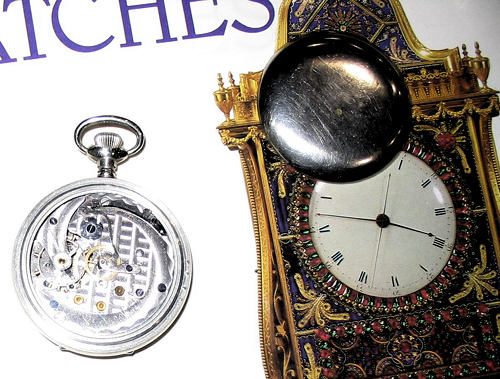
Following its initial purchase, the purchaser graciously allowed Carl to inspect the watch. As luck would have it Carl happened to be working on the very same model watch the evening before. An NAWCC member since 1974, he proceeded to identify not-so-obvious technical problems behind the dial, including a missing chronograph spring, and was offered the opportunity to purchase the watch. Carl was pleased to accept.
The Works-in-Progress table contained the remains of a once lovely Terry & Sons pillar and scroll-style wooden movement shelf clock. The clock had long ago fallen victim to an errant pet cat hunting dust mice on a fireplace mantle. A team of chapter members has assembled to restore the clock with the goal of possible entry in the NAWCC's documented restoration craft competition. Stay tuned for a progress report.
Member Al Comen informed us of an outstanding collection of Salem Bridge clocks on exhibit at the Naugatuck Historical Society museum in Naugatuck, Connecticut. We encourage members to visit, enjoy and spread the word about other local museum clock and watch collections of interest.
Finally, members are encouraged to contact Cheryl Comen or Jim Katzin for information regarding the chapter's suitcase repair instruction program. A former NAWCC instructor from Stratford has been located. A very happy New Year to all!
Meetings In 2005
Meetings In 2004
Meetings In 2003
Meetings In 2002
Meetings In 2001
Meetings In 2000
Meetings In 1999
Meetings In Years 1996 - 1998
|

 The March mart was also a fantastic day for reference books, both new and rare. Among many treasures spotted were a reprint of an early work on milling and milling machines originally published in 1919, and Michael Balfour's The Classic Watch, 2002 (see photo of Kathy Kaddis holding the book).
The March mart was also a fantastic day for reference books, both new and rare. Among many treasures spotted were a reprint of an early work on milling and milling machines originally published in 1919, and Michael Balfour's The Classic Watch, 2002 (see photo of Kathy Kaddis holding the book).
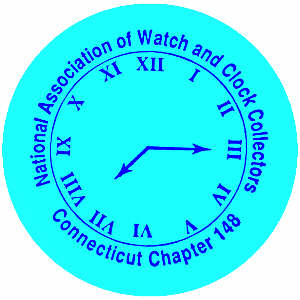
 The mart featured another in a series of thought-provoking impromptu exhibits provided by member David Follett. David's collecting interests encompass a broad spectrum of the field; his exhibits draw on resources of a fine library and collection. As the happy result, David's table connects and uplifts passers-by.
The mart featured another in a series of thought-provoking impromptu exhibits provided by member David Follett. David's collecting interests encompass a broad spectrum of the field; his exhibits draw on resources of a fine library and collection. As the happy result, David's table connects and uplifts passers-by.


 The chapter met on July 15, a sultry Saturday morning marking the end of Brimfield week. Entering the Edmond Town Hall's quaint, cool basement, members found much to spark their interest and conversation.
The chapter met on July 15, a sultry Saturday morning marking the end of Brimfield week. Entering the Edmond Town Hall's quaint, cool basement, members found much to spark their interest and conversation. Another object that attracted well-deserved attention was an early-to-mid-19th century wall timepiece with the label of John Peacock, probably American, hitherto unknown (see photo). Research efforts are underway.
Another object that attracted well-deserved attention was an early-to-mid-19th century wall timepiece with the label of John Peacock, probably American, hitherto unknown (see photo). Research efforts are underway. Gerry's achievement is no small accomplishment. Elaborate steaming, bending, and press-forming processes, not to mention scarce materials required for this classic rendered it very costly to produce in its own time. Gerry began by studying existing examples in museums, and by experimentation, -- the latter at first resulting in failure.
Gerry's achievement is no small accomplishment. Elaborate steaming, bending, and press-forming processes, not to mention scarce materials required for this classic rendered it very costly to produce in its own time. Gerry began by studying existing examples in museums, and by experimentation, -- the latter at first resulting in failure.